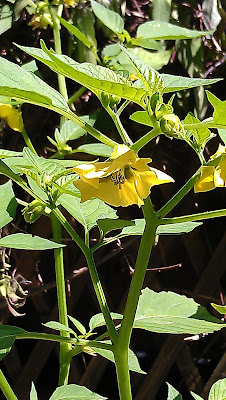 One of our most successful crops this year in the Secret Garden was the tomatillos. We grew them last year specifically for MsMarmiteLover’s Frida Kahlo dinner and we liked them so much that we planted again this year.
One of our most successful crops this year in the Secret Garden was the tomatillos. We grew them last year specifically for MsMarmiteLover’s Frida Kahlo dinner and we liked them so much that we planted again this year.
These are tomatillos: tall spreading plants that need support, and these are the fruits themselves, looking like green tomatoes in a papery husk. If they remind you of physalis (Cape Gooseberries) that’s because they are closely related. Tomatillos are also cousins of potatoes, tomatoes and so also of aubergines – all members of Solanaceae. (If you grow potatoes you may have noticed that the potato plants sometimes produce small green berries that look similar to a tomatillo. Don’t be tempted to try them: potato berries are poisonous – as indeed is the entire plant, apart from the tubers).
 The stems are quite slim and green as well, so you will need to give them a cane support as they grow – another reason for not putting them in too exposed a place. But make sure you plant at least two reasonably close together -these plants do not self-pollinate and need another tomatillo nearby to ensure pollination, Without pollination, there will be no fruit.
The stems are quite slim and green as well, so you will need to give them a cane support as they grow – another reason for not putting them in too exposed a place. But make sure you plant at least two reasonably close together -these plants do not self-pollinate and need another tomatillo nearby to ensure pollination, Without pollination, there will be no fruit.
Protect the seedlings from slugs when you first plant them out – once they’re established and bigger the slugs find them less tasty. Once you have ensured the plants have support you can pretty much leave them to their own devices. They don’t need huge amounts of regular water like tomatoes – in fact they don’t like sitting in the wet at all and here in London with our clay soil we probably don’t have soil as well-drained as the tomatillo would like.
Repeat until the seeds are well separated from the fruit. Put the remaining flesh and seeds back into the bowl and cover with water again. The heavy seeds -the good seeds – will sink to the bottom. The light seeds – which are not viable – and fibres will rise to the top. Leave the bowl alone while the seeds settle, then pour off the surface flesh and seeds, leaving you with just the good ones.
PS: should you not have a garden, this year Riverford Organics have been growing tomatillos and you can request to add them to your box.





Yes it's amazing how difficult they are to get hold of in the Uk when they are so easy to grow. I even spoke to the grower at The Isle of Wight Tomato stall company and he said they were too hard to grow. Rubbish!
I love these tomatillos, just as I love all sour foods. There is a tomatillo salsa recipe in my book Supper Club: recipes and notes from the underground restaurant
Actually another thing. You can use tomatillos raw. I use them raw for my salsas. If you let the tomatillos go wrinkly, they are even better raw.